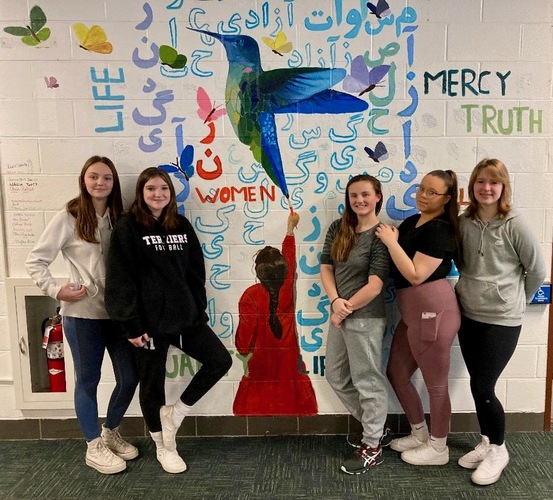WESTMINSTER — Ninth-grade students in the Global Citizenship class at Bellows Falls Union High School took a unique route toward learning about justice on the international stage this school year.
They used art.
More specifically, they designed and painted a mural in the school entry hall this past fall with the help of Afghanistan political refugee and artist Negina Azimi.
John Ungerleider, director of the Great Falls Community Justice Center, also helped organize the project.
Teacher Laura Tabachnick described the month-long mural process as “a very cool experience,” describing Azimi as “an incredible person who experienced some powerful events and was sharing them [with the class].”
Azimi was the first woman muralist member of the ArtLords, an activist group of artists established in Kabul, Afghanistan in 2014. It's part of an international grassroots movement of artists “motivated by the desire to pave the way for social transformation and behavioral change through employing the soft power of art and culture as a non-intrusive approach,” according to the ArtLords website.
Born in Kabul, Azimi has a degree in law. She was also a fine arts student for two years and spent four years doing murals in Kabul with the ArtLords.
The Taliban reclaimed control of Afghanistan in August 2021. The oppressive, authoritarian regime promptly whitewashed the murals the ArtLords had painted in the city, destroying them.
Azimi said she “left Afghanistan within a week” after the Taliban's resurgance. She first spent eight months in exile in Albania, then was able to come to the United States: first to Virginia and then, a month later, to Vermont.
One of the 130 Afghan refugees who have settled in the Brattleboro area, Azimi says she feels she has found her home here, where “I have freedom to do my artwork.”
Shortly after they arrived here, she and other refugee artists, using photographs, started reproducing all the murals destroyed in Kabul. Azimi said they have finished “many projects in the last eight months.”
She said she is planning another mural project at Dummerston School.
Representing freedom and justice
As is true with many of the ArtLords' projects, freedom and justice are the basic themes of the BFUHS mural, which is not a reproduction of the lost art in Afghanistan. The mural incorporates and integrates ideas from students by design.
Ninth-grader Tatiana Charon explained that Azimi started the discussion with her class by “diving deep into justice,” especially as she experienced it - or failed to experience it - in Afghanistan.
Azimi's revelations about life in her home country made an impression.
In Afghanistan, “women can't go to school, and they can't go outside without a man with them,” Charon said. “And when they do, they have to be completely covered from head to foot.”
Classmate Jasmine Perry-Ives said that Azimi, using dialogue circles with all the students participating, “asked us to come up with our own thoughts about justice and how to incorporate that into the mural. Everyone in the class contributed ideas. We came up with this all together.”
Other students involved in the project include Olivia Hallock, Aly Streeter, Myleigh Illingworth, Addison Bacon, Exavier Lockerby, Joaquin Martinez, Veronica Moore, Beatrix Robb, Gilliian Robb, Dean Ryea, Conner Stevens, Addison Terry, Jamie Thibault, and Jake Tostrup.
Artistic defiance
Azimi said that “the kids really enjoyed working on this, as did I.”
With 16 students in the class, a lot of ideas came up in their discussions with the artist.
“There were many different thoughts and opinions,” Azimi said. “The project included parts of everyone's ideas.”
Azimi said that she came up with the mural design using everyone's ideas, then drew it on the wall in pencil. All of the students participated in actually painting the final product.
The students explained that the background includes the letters of the Persian alphabet. There are also several colored-in words in the Dari language with the English meaning next to them.
The English translations include “freedom,” “mercy,” “truth,” “women,” “peace,” “equality,” and “life.”
In the foreground, a young woman reaches up with a paintbrush, putting the finishing touch on a hummingbird taking flight. The students explained that the girl is a “symbol of women making art to reach out for freedom in a peaceful environment.”
Azimi offers an artist's statement about the project,
“For girls and women in Afghanistan today, who are not allowed to go to school, illiteracy deprives them of the capacity to make meaning and define justice for themselves,” she wrote.
“The artwork is intended to stimulate all our thinking about the many facets and meanings of justice at BFUHS, in Bellows Falls, in Vermont, the United States and in the world.”
Despite the Taliban's destruction of the Kabul murals, Azimi said she still has “thoughts that art cannot truly be banned.”
As a reflection of that defiance, she said that she is “continuing my artwork here, with the same message - the rights of women.”
